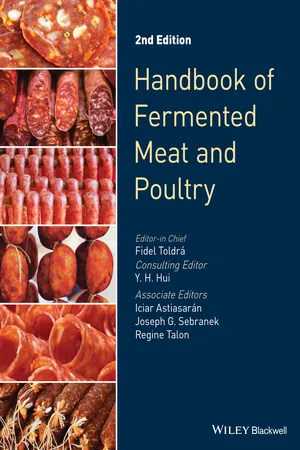
- English
- ePUB (mobile friendly)
- Available on iOS & Android
Handbook of Fermented Meat and Poultry
About this book
Fermented meat products have been consumed for centuries in many different parts of the world and constitute one of the most important groups of food. Bacterial cultures are used in their manufacture to preserve the meat and confer particular textures and sensory attributes. Examples of fermented meats include salami, chorizo, pepperoni and saucisson.
This fully revised and expanded reference book on meat fermentation presents all the principle fermented meat products and the processing technologies currently used in their manufacture. The 54 chapters of this substantial book are grouped into the following sections:
- Meat fermentation worldwide: overview, production and principles
- Raw materials
- Microbiology and starter cultures for meat fermentation
- Sensory attributes
- Product categories: general considerations
- Semidry-fermented sausages
- Dry-fermented sausages
- Other fermented meats and poultry
- Ripened meat products
- Biological and chemical safety of fermented meat products
- Processing sanitation and quality assurance
There are five new chapters in the second edition that address the following topics: Smoking and new smoke flavourings; Probiotics; Methodologies for the study of the microbial ecology in fermented sausages; Low sodium in meat products; and Asian sausages.
Handbook of Fermented Meat and Poultry, Second Edition provides readers with a full overview of meat fermentation, the role of microorganisms naturally present and/or added as starter cultures, safety aspects and an account of the main chemical, biochemical, physical and microbiological changes that occur in processing and how they affect final quality. Finally, readers will find the main types of worldwide fermented meat products, typically produced in different areas, with the description of their main characteristics.
Frequently asked questions
- Essential is ideal for learners and professionals who enjoy exploring a wide range of subjects. Access the Essential Library with 800,000+ trusted titles and best-sellers across business, personal growth, and the humanities. Includes unlimited reading time and Standard Read Aloud voice.
- Complete: Perfect for advanced learners and researchers needing full, unrestricted access. Unlock 1.4M+ books across hundreds of subjects, including academic and specialized titles. The Complete Plan also includes advanced features like Premium Read Aloud and Research Assistant.
Please note we cannot support devices running on iOS 13 and Android 7 or earlier. Learn more about using the app.
Information
Part I
Meat Fermentation Worldwide: Overview, Production, and Principles
Chapter 1
Dry-Fermented Sausages and Ripened Meats: An Overview
1.1 Introduction
- addition of nitrite, salt, and/or sugar;
- reduction of redox potential;
- introduction of lactic acid bacteria (LAB);
- lowering of pH;
- decreasing of aw;
- smoking.
1.2 Fermented sausages and ripened meats around the world
1.2.1 North America
1.2.2 South and Central America
1.2.3 The Mediterranean
1.2.4 Northern Europe
Table of contents
- Cover
- Title Page
- Copyright
- List of Contributors
- Preface
- Part I: Meat Fermentation Worldwide: Overview, Production, and Principles
- Part II: Raw Materials
- Part III: Microbiology and Starter Cultures
- Part IV: Sensory Attributes
- Part V: Product Categories: General Considerations
- Part VI: Semidry-Fermented Sausages
- Part VII: Dry-Fermented Sausages
- Part VIII: Fermented Products from Poultry and Other Meats
- Part IX: Ripened Meat Products
- Part X: Biological and Chemical Safety of Fermented Meat Products
- Part XI: Processing Sanitation and Quality Assurance
- Index
- Food Science and Technology Books
- End User License Agreement